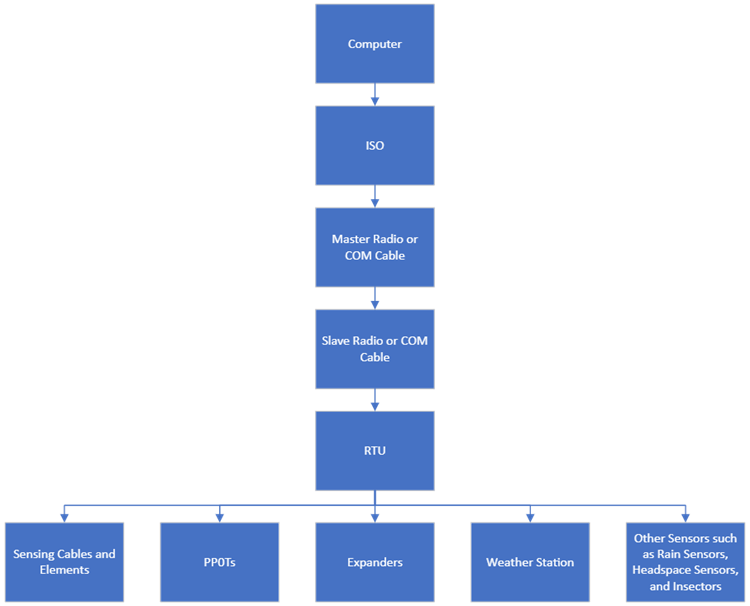When troubleshooting an Integris System, there is a specific methodology that has been found to be effective. First, we recommend you start at the PC and work your way out from there. That is, make sure the PC is working and then move onto the next connected piece of equipment and troubleshoot that, going forward until you have identified the issue.
Below, is a pictoral representation of the recommended troubleshooting flow.

There may be cases where you can narrow down your troubleshooting efforts to other equipment based on the problem symptoms, but as a general action plan for troubleshooting an Integris system, this method is thorough and effective. You should start out with the first step and then proceed to the next if the issue is not resolved.
1. Power Cycling: Sometimes equipment gets hung up on a fault or needs to be reset in order to clear an error. Power cycling equipment can resolve such issues. For example, you can power cycle an RTU to try and restore communication between the PC and the RTU. Also, Power cycling the radios on the bin yard can restore communication as well.
2. The “Eye” test: Often the first thing that should be done is visually inspecting the equipment for damage and changing the equipment as necessary. Equipment such as wiring, and sensing cables can get damaged in a busy bin yard. Replacing damaged equipment is often the first step to resolving issues with Integris Software.
3. Confirming Power: Often communication will go down because of a loss of power to a key piece of equipment. This should be one of the first troubleshooting steps to take when diagnosing a problem on an Integris system.
4. Check Equipment Configurations: As with most systems, it is easy to make mistakes when installing or changing a piece of equipment. Sometimes problems can show up on an Integris System due to improper installation or configuration of the equipment on the site. Therefore, it is an important step to check and correct any improper installations or deployments on the site.
5. Remove Equipment: Sometimes broken or damaged equipment can bring a whole system or part of a system down with it. For example, a bad temperature cable element can stop the RTU it is connected to from communicating with the PC, and the only way to resolve the issue is to disconnect the bad temperature cable element. If you suspect that a piece of equipment is bad but do not know which one it is that is connected to an RTU, you can figure it out through the process of elimination.
First, remove everything from the RTU and confirm the RTU is working properly on its own and getting good ID commands. Then start adding equipment back in until you have identified the faulty component. You need to power cycle the RTU between each change and wait for new commands to come in before moving on to the next part.
Once you identify the bad equipment, you can work towards replacing it to make the system whole again.
